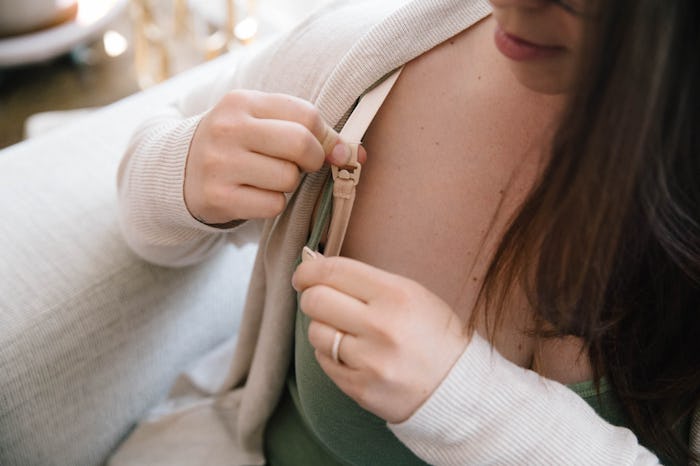My son had a total crap latch. This meant that for a few weeks, until we really got the hang of breastfeeding, my nipples felt like someone had clamped them and then took sandpaper to their tips. I went to the lactation consultant begging, "How do I treat bleeding nipples?" because I was desperate and reasonably certain my son was going to become vampiric pretty soon if he kept getting my gnarly nipples for lunch.
According to the National Health Service (NHS) in the U.K., sore and cracked nipples are pretty common. I know that when I was having latch issues, my lactation consultant could tell by the pattern of the cracking what my son's latch issue was. I'm not kidding. She evaluated my nipples like I evaluate my Netflix choices before bingeing — with great care and precision.
According to the NHS, bleeding nipples are most likely due to a latch issue, but can sometimes point to a deeper issue like an infection or mastitis, so it's best if you call your OB-GYN to make sure that it's just a superficial nipple issue — especially if you have an inflamed breast or fever. Having had both a latch issue, and later mastitis (also thrush and several plugged ducts — I am the walking version of Murphy's Law), I will tell you that latch and cracking and bleeding nipples can get better. If you're wondering how to treat bleeding nipples now, don't worry. I asked an expert.
I spoke to International Board Certified Lactation Consultant (IBCLC) Tiffani Cullen about what I lovingly refer to as "nightmare nips," and she tells Romper, "There's not a panacea that's going to work for all moms, and it may keep happening. Yes, you need to treat your nipples because you're not going to want to continue breastfeeding if you are in extreme pain, but if the latch doesn't get fixed, your nipples are never going to heal." She warns that you should see an IBCLC as soon as possible to address the latch issue.
"As far as treating the nipples," Cullen says, "there are a few things you can do." She suggests rinsing your nipples after a feeding with sterile saline solution. This is not the stuff from the big bottles of contact lens solution, but is sold in individual packets at the pharmacy. Cullen then says to pat them dry very gently with a clean cloth. After you've done that, she says to apply medical-grade lanolin or another moisture barrier, like Aquaphor, to the irritated area, and use plastic-free nipple pads, replacing them at each feeding. If your doctor prescribes an antibiotic cream, use that in place of the lanolin or Aquaphor, Cullen says.
She also tells Romper that you should try to keep your nipples free to the air as much as possible, and that applying a little breast milk to the irritated area can speed healing. "Try to keep your feedings short, and just before you nurse, apply an icepack that's been wrapped in a cloth to the nipple for about 30 to 45 seconds to numb the area before your baby latches," she adds. "Also, you can take Motrin or Tylenol for pain as necessary, as they're both compatible with breastfeeding." She recommends that in between feedings, rotate ice and air on your nipples, which will decrease inflammation and hurry the healing process while providing much needed pain relief.
Cullen says that once your baby perfects their latch, the problem should slowly go away, leaving you and baby much happier. My son went on to nurse like a champ for almost two years, and by the time I had my daughter, I'm fairly certain my nipples were at least part bionic. If yours are causing you grief, make sure you see an IBCLC or call your OB-GYN to get a bead on the root cause of the issue, so that all your treatments aren't for naught.
